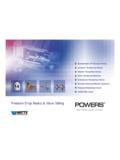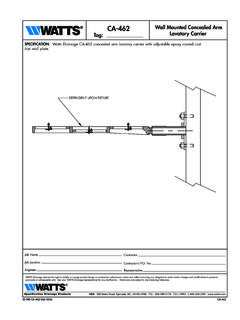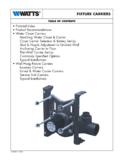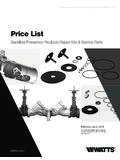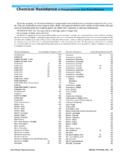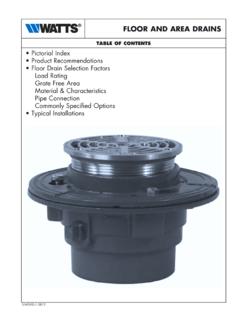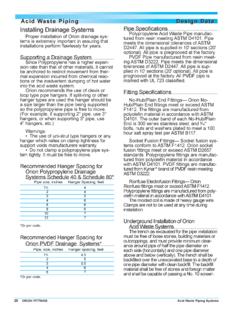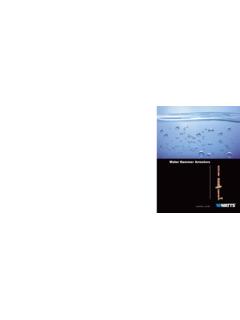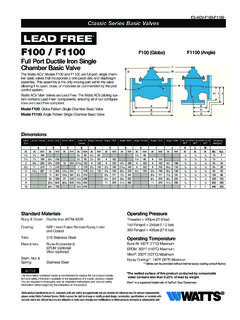Transcription of Cross-Connection Questions, Answers & Illustrations
1 50 50. Cross-Connection Questions, Answers & Illustrations Relating to Backflow Prevention Products and Protection of Safe Drinking Water Supply 1 What is backsiphonage? Backsiphonage is the reversal of normal flow in a system caused by a negative pressure (vacuum or partial vacuum). in the supply piping. 2. What factors can cause backsiphonage? Backsiphonage can be created when there is stoppage of the water supply due to nearby firefighting, repairs or breaks in city main, etc. The effect is similar to the sipping of a soda by inhaling through a straw, which induces a flow in the opposite direction. 3 What is backpressure backflow? Backpressure backflow is the reversal of normal flow in a system due to an increase in the downstream pressure above that of the supply pressure. Feed Supply 4. Valve What factors can cause a backpressure backflow condition? Backpressure backflow is created whenever the downstream pressure exceeds the supply pres- sure which is possible in installations such as heating systems, elevated tanks, and pressure-producing systems.
2 An example Return would be a hot water space-heating boiler operating under 15-20 Boiler lbs. pressure coincidental with a reduction of the city water supply below such pressure (or higher in most commercial boilers). As wa- ter tends to flow in the direction of least resistance, a backpressure backflow condition would be created and the contaminated boiler water would flow into the potable water supply. 5 What is a Cross-Connection ? A Cross-Connection is a direct arrangement of a piping line which allows the potable water supply to be connected to a line which contains a contaminant. An example is the common garden hose attached to a sill cock with the end of the hose lying in a cesspool. Other examples are a garden hose attached to a service sink with the end of the hose submerged in a tub full of detergent, supply lines connected to bottom-fed tanks, supply lines connected to boilers. 6 What is the most common form of a Cross-Connection ? Ironically, the ordinary garden hose is the most common offender as it can be easily connected to the potable water supply and used for a variety of potentially danger- ous applications.
3 2. 7 What is potentially dangerous about an unprotected sill cock? The purpose of a sill cock is to permit easy attachment of a hose for outside watering purposes. However, a garden hose can be extremely hazardous because they are left submerged in swimming pools, lay in elevated locations (above the sill cock) watering shrubs, chemi- cal sprayers are attached to hoses for weed-killing, etc.; and hoses are often left laying on the ground which may be contaminated with fertilizer, cesspools, and garden chemicals. 8 What protection is required for sill cocks? A Hose Bibb Vacuum Breaker should be installed on every sill cock to isolate garden hose applications thus protecting the potable water supply from contamination. 9 Should a Hose Bibb Vacuum Breaker be used on frost-free hydrants? Definitely, providing the device is equipped with means to permit Hose Bibb Vacuum Breaker Watts 8. the line to drain after the hydrant is shut off. A removable type Hose Bibb Vacuum Breaker could allow the hydrant to be drained, but the possibility exists that users might fail to remove it for draining purposes, thus defeating the benefit of the frost-proof hydrant feature.
4 If the device is of the Non-Removable type, be sure it is equipped with means to drain the line to prevent winter freezing. 10 Can an Atmospheric, Antisiphon Vacuum Breaker be installed on a hose bibb? Theoretically yes, but practically no. An Antisiphon Vacuum Breaker must be elevated above the sill cock to operate properly. Hose Bibb Vacuum Breaker This would require elevated piping up to the vacuum breaker and for Frost-Proof Hydrants down to the sill cock and is normally not a feasible installation. Watts NF8. On the other hand, a Hose Bibb Vacuum Breaker can be attached directly to the sill cock without plumbing changes and at minor cost. 11 What is an Atmospheric Vacuum Breaker? The most commonly used Atmospheric Antisiphon Vacuum Break- ers incorporate an atmospheric vent in combination with a check valve. Its operation depends on a supply of potable water to seal off the atmospheric vent, admitting the water to downstream equipment. If a negative pressure develops in the supply line, the loss of pressure permits the check valve to drop sealing the orifice while at the same time the vent opens admitting air to the system to break the vacuum.
5 Atmospheric Vacuum Breaker Watts 288A 3. 12 Will an Antisiphon Vacuum Breaker protect against a backpressure backflow condition? Absolutely not! If there is an increase in the downstream pressure over that of the supply pressure, the check valve would tend to modulate thus permitting the backflow of contaminated water to pass through the orifice into the potable water supply line. 13 Can an Atmospheric Vacuum Breaker be used on lawn sprinkler systems? Yes, if these are properly installed, they will protect Antisiphon Vacuum the potable water supply. The device shall be Breaker Sprinkler Heads installed 6" above the highest sprinkler head and shall have no control valves located downstream Ground Level from the device. 14 Can an Atmospheric Vacuum Breaker be used under continuous pressure? Single Zone System Drip Valve at Low Point in System No! Codes do not permit this as the device could become frozen and not function under an emergency condition. 15.
6 Can a Pressure Vacuum Breaker be used on a multizone lawn sprinkler system? Yes. This type of vacuum breaker can be used under continuous pressure. Therefore, if properly installed, it will protect the potable water supply. Pressure Vacuum Breaker The device shall be installed 12" above the Sprinkler Heads highest sprinkler head. Drip Valves at Lowest Point 16 What is continuous pressure? This is a term applied to an installation in which the pressure is being supplied continuously to a backflow Zone Shutoff Valve Zone control Valve preventer for periods of over 12 hours at a time. Laboratory Multizone System faucet equipment, for example, is entirely suitable for a non- pressure, atmospheric antisiphon vacuum breaker because the supply is periodically being turned on and shut off. A vacuum breaker should never be subjected to continuous Feed Valve Supply pressure unless it is of the continuous pressure type and clearly identified for this service. 17.
7 Are check valves approved for use on Drain boiler feed lines? Return Boiler Most jurisdictions require backflow protection on all boiler feed lines. Some will allow a backflow preventer with intermediate vent as minimum protection for residential boilers. A reduced pressure backflow preventer is generally required on commercial and compound boilers. However, low cost, continuous pressure backflow preventers are now available which will perform with maximum protection; thus check valves are not recommended. 4. Chicken House 18 What is the difference between pollution and contamination? Pollution of the water supply does not constitute an actual Antibiotic Solution Unapproved Single Check Valves Public health hazard, although the quality of the water is Private Water impaired with respect to taste, odor or utility. Contami- Well Backflow from Supply Chicken House nation of the water supply, however, does constitute an actual health hazard; the consumer being subjected to Chicken House cross - potentially lethal water borne disease or illness.
8 connection , Spring 1991. 19 What recent case would reflect users being exposed to contamination of the water supply? Chicken House Cross-Connection , Spring 1991. In response to Watts 800 Series a complaint from a customer on the Casa Water System (Perry Vacuum Breaker County), a staff member of the Division of Engineering found should have been that the water systems had been contaminated by backflow Installed Here Water Supply from chicken houses. The water system connected to the from Free Flow chicken houses included two single check valves in series Artesian Well for backflow prevention purposes. The water was being used to administer an antibiotic solution to the chickens. Spray Tank with Water and 2-4-D. 20 What other case reflects users being ex- posed to contamination of the water supply? On or about the week of the 14th of May, 1991, a backsiphonage Pump and Supply Tank for Water Supply to House problem occurred. A local farmer reported the problem on his farm.
9 2-4-D Backsiphonage Case He was filling a spray tank on his farm with water and 2-4-D. The wind kept blowing the fill hose away from the fill spout so he extend- ed the hose down into the tank. As the tank filled, he went onto other duties. He went into the house for some reason and his wife told him that the water had become salty tasting. He immediately thought of the 2-4-D and went to the tank, and it had began siphoning water from the tank. He told his wife not to use any more water. An artesian well, (free flow) was filling the tank. The artesian well also supplied water to the home through a storage tank and pump system. As the spray tank was filling, the pump in the house came on and created a pull on the well greater than the pressure at the well head. Conse- quently, as the pump was on, it was also pulling the 2-4-D and water from the spray tank. 21 Are there any records of recent cases involving unprotected cross -connections? The startling fact is that cross -connections continue to occur and there are documented cases involving reverse flow.
10 For other cases, request folder F-SBN. 22 What recently reported cases occurred in a plant? In addition to the case described in No. 19 , there are other reports, but because of the possibility of litigation for pending cases, information can be difficult to obtain. However, in San Francisco, an industrial plant had a submerged water inlet supplying a lye vat. Immediately adjacent to this installation was the employee's shower room. Officials fortunately discovered the Cross-Connection but were alarmed that employees could potentially be bathing in water contaminated with lye from the vats. 5. 23 What case was reported involving a school? Most people are familiar with the details of the Holy cross football team's hepatitis incident, which was later determined to be caused by a backflow of con- taminated water. It took close to nine months for officials to determine that a severe fire in nearby Worcester lowered the pressure in the football field area to the point where a backpressure backflow condition was created allowing contaminants from a sunken hose bibb pit to backflow into the field house drinking bubbler.

